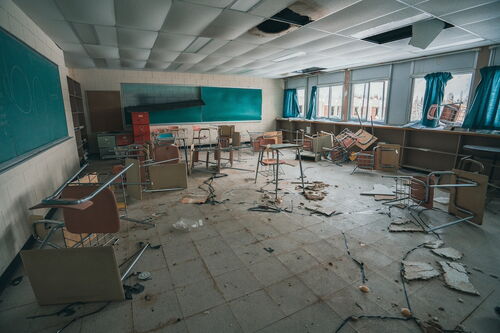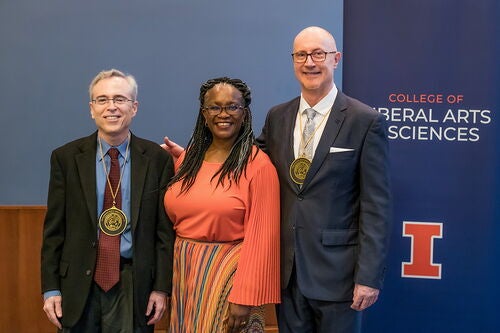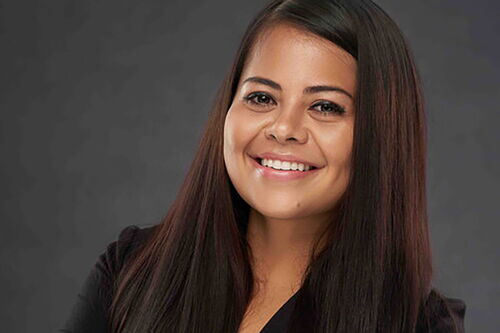The new potential for design thinking
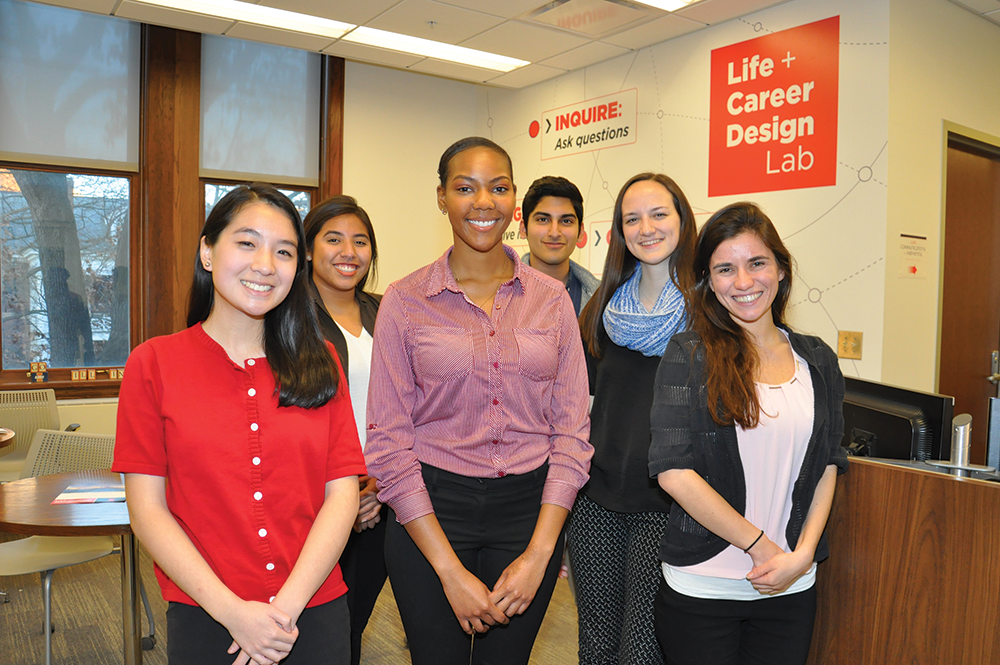
Beautiful art. Monolithic buildings. Microscopic machines. Since humankind first picked up tools, design has been used to create the physical objects that shape our world. But what if the same approaches that enable us to design the physical world could be used to engineer a better life?
This past October, the College of LAS took the wraps off of a brand-new program to do just that. Called the Life + Career Design Initiative, it’s a new program designed to help students not just choose a career but to move through their time at Illinois with purpose and intent, acquiring the experiences they need to find their passion—and the tools they need to pursue it.
“We want 100 percent of our sophomores to have a career development plan,” said Barbara Hancin-Bhatt, associate dean of student affairs at LAS. “The question was, ‘How do you get someone to make a goal of that nature?’ You can expose them to internships. You can expose them to experiential learning or professional development opportunities, but how do you get them to imagine that and see how it all fits together with their academic program and co-curricular activities into a coherent narrative about their Illinois experience and how it has impacted them?”
The initiative was preceded by three years of groundwork in LAS as advisors and college staff leading undergraduate academic affairs imagined how best to assist students with career development. As they worked on bringing the concept of design thinking to life, university administrators working separately from LAS announced in fall 2016 that a new Siebel Center for Design Thinking would open on campus in 2020. The announcement affirmed for Hancin-Bhatt and her colleagues that they were on the right path in helping students build tools to inquire, engage, and create their future.
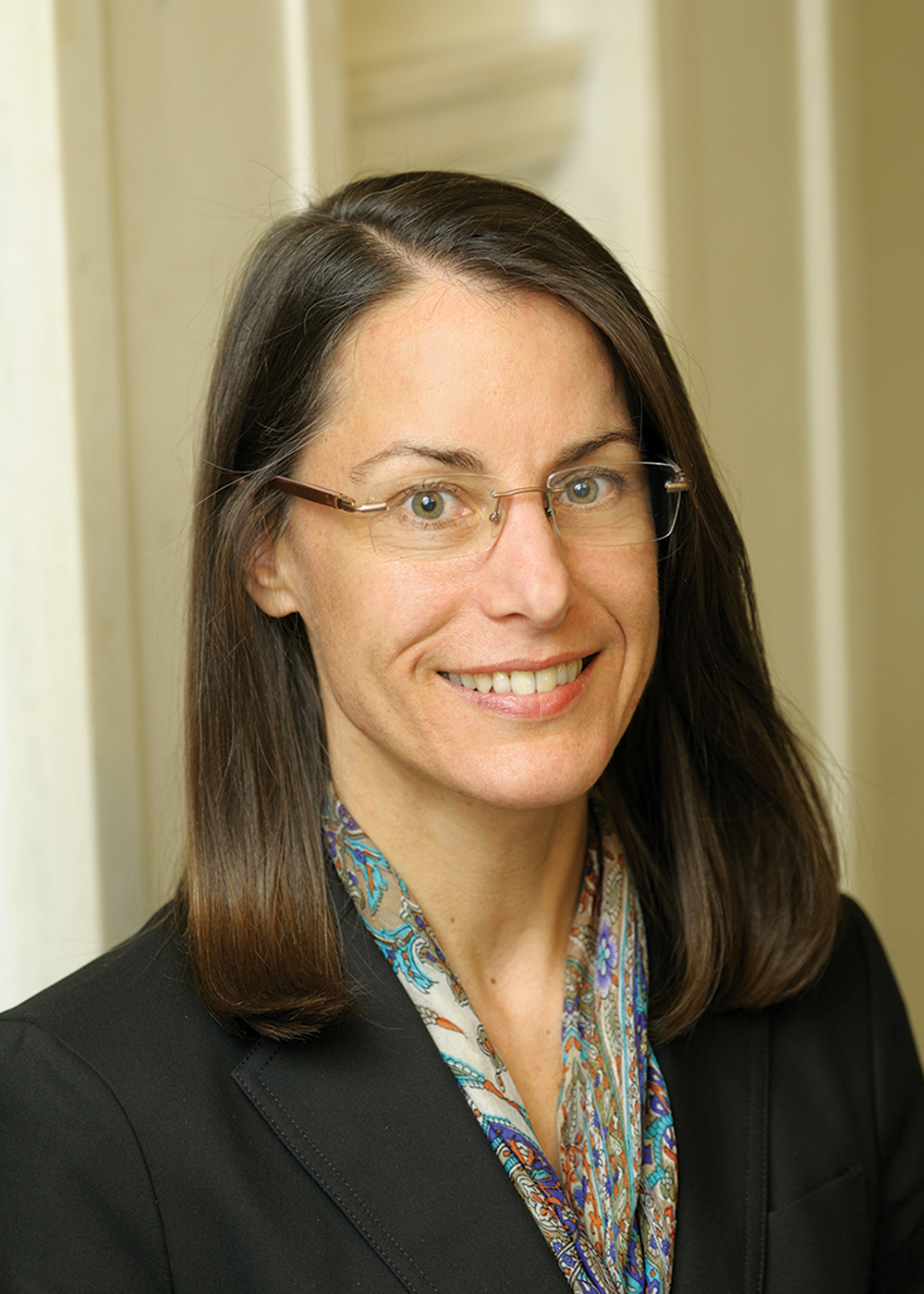
Born out of lean engineering and other corporate innovation methodologies, design thinking is a fluid way of problem solving that uses tools such as empathy, “radical collaboration,” and prototyping to rapidly bring new ideas to fruition. And for years, companies like Apple and Coca-Cola have been using it to create products that give them the edge.
In 2007, Bill Burnett, executive director of Stanford University’s design program, and Dave Evans, co-founder of gaming juggernaut Electronic Arts, were among the first to apply these principles to life planning. Together, they created “Designing Your Life,” which eventually became a top elective at Stanford and the subject of a No. 1 New York Times best-seller, “Designing Your Life: How to Build a Well-Lived, Joyful Life.”
Kyle Williams was a student in Designing Your Life at Stanford as he wrapped up his master’s degree, and he was invited to be the first fellow in Stanford’s newly established Life Design Lab where he was a teacher for the course and a key participant in shaping the curriculum for the follow up class, Designing Your Stanford. So when his resume crossed Hancin-Bhatt’s desk in late 2016, she realized she had the perfect consultant to help transform the educational experience of students at LAS.
What she and her new team envisioned wasn’t merely a class; it was a way of engaging students at multiple points throughout their journey to create a different mindset.
“Many students don’t start to think about life out of college until their last semester in school,” said Brian Neighbors, director of career development for the college. “We’ve got to change the culture to where students actually understand the significant value of the LAS degree.”
That means starting in the beginning. This past fall, the school unveiled a new pilot program for LAS 101 incorporating many design principles. Taught by Murillo Soranso, director of first year experience in LAS, and two College of LAS advisors, Melissa Newell, director of undergraduate studies from the Department of Economics, and Tonya Pulley from the School of Integrative Biology, the class helped students learn how to reframe problems, unleash the power of collaboration, and create multiple way-finding maps that enabled them to pursue their goals while embracing opportunities as they arose.
The ability to adapt is important for emerging graduates who, studies indicate, may experience as many as 13 different careers after graduation.
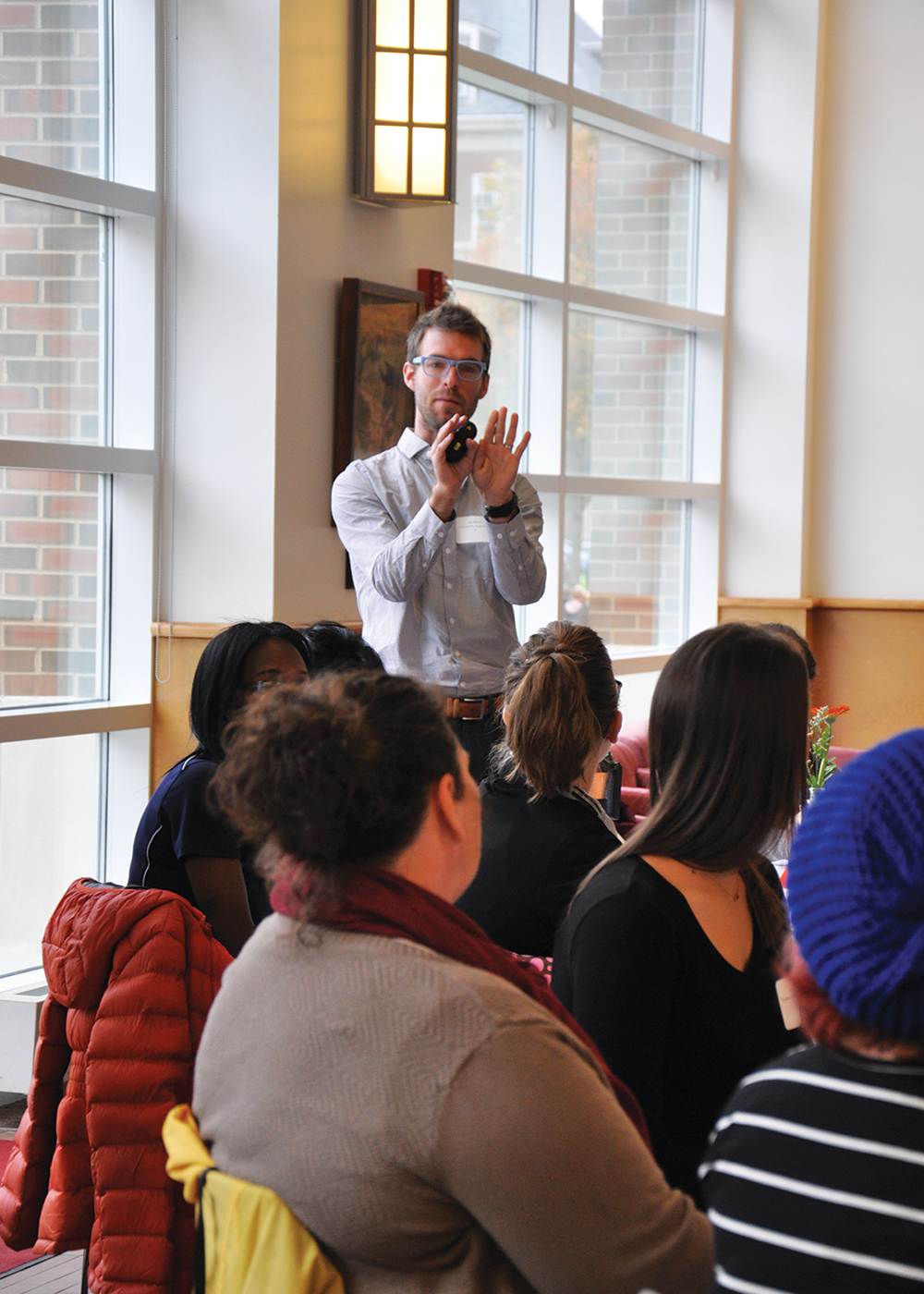
“That’s why I think the framework is so useful,” said Neighbors. “We’re guiding these students to go out into the world with a wayfinding map to start exploring connections, engaging in experiences, and reflecting on what they learn from the experiences.”
This spring, the college launched LAS 201: Design Your Illinois, where students will map out their broader university experience. That will eventually be followed by a third course—Designing Your Life + Career—created specifically for upperclassmen. The college is also hosting numerous workshops led by people such as Soranso that help expose students, faculty, and advisors to design thinking.
In addition, the LAS 291/292: Global Perspectives courses help about 1,400 students who travel abroad annually apply design thinking to build empathy and thrive in new environments, a skill that the course director, Nicole Lamers, believes all students need to acquire.
Lamers said that many employers have reported that they do not value study abroad experience very highly, as students have not traditionally been able to articulate the value that they derive from their experience. This course sequence helps students to set goals that will help them professionally, reflect on their experiences – and what they have gained – and then helps them to articulate those gains into tangible skill sets that employers are seeking.
“The nature of work in the 21st century is changing, and the problems our students will face in their various vocations will call on both the depth of their disciplinary knowledge and their ability to move across multiple domains of knowledge and practice,” said Kevin Hamilton, senior associate dean of the College of Fine and Applied Arts, who served on the university’s Design Initiative executive committee and provided critical support for the program at the College of LAS. “In a large research university like this one it can be hard to help students through the discovery of something as personal and even principled as a ‘vocation’ and not just the narrower term of a ‘career.’ The LAS effort seems to be thinking big to this end.”
Andy Singer, interim director of the new Siebel Center for Design, agrees. “It’s very exciting that LAS has taken the initiative and really gotten in front of this. Who better than our humanists to understand the human-centered element in innovation? It’s fantastic that LAS is saying, ‘Hey, we need to think about how one designs their life. We need to think about what are the human-centric and human-focused elements of your campus experience.’”
In the long run, Singer believes the entire university will benefit. “Any design thinking courses, programs, or projects on our campus need people from LAS,” he said.
As for the consultant who helped to create one of the first fully-integrated career design thinking programs in the country? Williams believes the initiative will have a major impact, transforming the answer to the one question students hear the most: What are you going to do with that liberal arts and sciences major?
“The culture around that question and the answer to that question is going to change for these students because of this thing,” Williams said, “and I think that’s really exciting.”
Life + Career Design Lab opens
Students Can Receive Face-To-Face Help for Planning
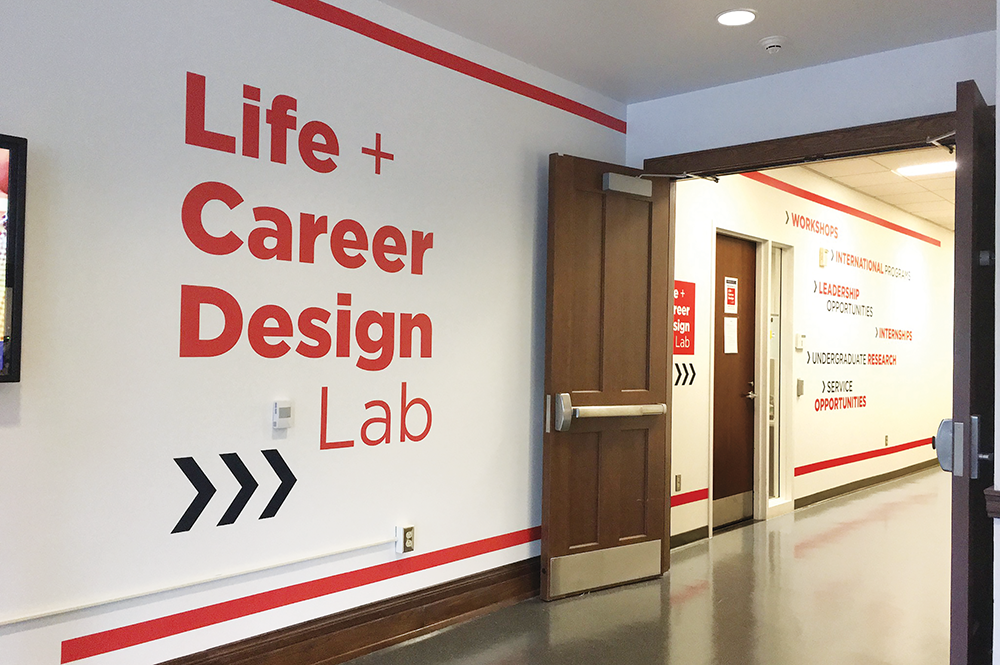
To change the way that students navigate their educational experience, you have to change how they connect with resources. The question is, how do you encourage students to explore all the possibilities of one school that incorporates 70 different majors?
For the College of LAS, the answer is the brand-new Life + Career Design Lab, which officially opened its doors on the second floor of Lincoln Hall in October. It’s not a large space. You won’t see rows of computers or bulging racks overflowing with dusty brochures. But what students will find when they walk through the door is something far more valuable—help from someone who’s been there.
“The lab is a place for students, faculty, and advisors to connect about life and career development,” said Erin Dittmer, a master’s student in curriculum and instruction who oversees six undergraduate interns chosen specifically for their experience in undergraduate research, internships, and studying abroad. “What makes it different from a typical career center is how we get students to integrate their academic program, co-curricular and other meaningful experiences into their career development, starting in LAS 101.”
That means exploring the reasons students want to undertake an internship or research opportunity as much as the steps to achieve it. Interns also help students prototype their goals, perhaps encouraging someone who wants to study abroad for a semester to first try a shorter program during spring break.
“That’s kind of encouraging the bias towards action,” explained Barghav Sivaguru, a lab intern majoring in political science and communication who specializes in undergrad research opportunities. “We really encourage them to think deeply and really look at all the resources available … If you have thought about it, and you think that taking that action is the best choice for you, don’t be afraid. You should do it!”
“We always try to make sure that students are doing something to work towards that internship or make themselves a better candidate,” added Vanessa Garcia, a major in Latina/o studies and political science, whether that’s getting a job on campus or joining a student organization. Even when they do, however, translating that experience to a resume can be a challenge for some. That’s when reflection— another key design thinking principle—can help them find their narrative and move forward with more confidence.
Cassandra Masters, a major in political science and history, remembers helping one student in that exact situation. She was pursuing a career in human resources, and Masters was able to help her realize that the work she did with student clubs was just as meaningful as any internship.
“That is HR work!” Masters told the student. “That’s communication skills. That’s all of those different things.” Masters said that validating those experiences and helping students make use of them is one of the things she finds most rewarding.
Even though the lab has been in operation for only a few months, Dittmer is excited about the interactions they’ve had and the way they’re helping students navigate what can often be a bewildering range of choices. Located in 2040 Lincoln Hall, the lab is open weekdays from 1 to 5 p.m. with no appointment required. All LAS undergraduate students are welcome, said Dittmer. She added: “We’d love to see a line out the door.”
Editor's note: These stories originally appeared in the Spring 2018 issue of LAS News magazine.






